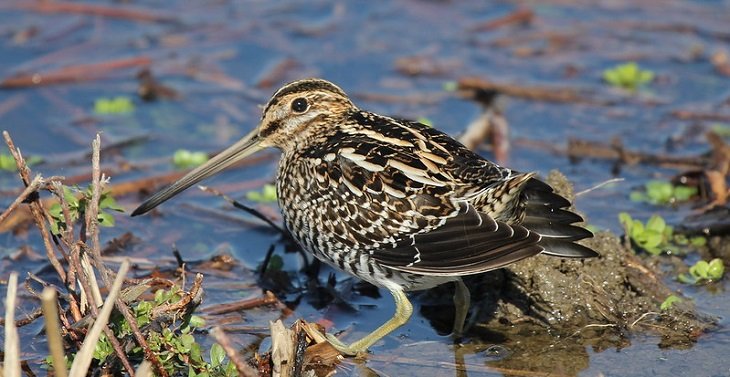
The birding world has been debating whether honorific common bird names (e.g., Clark’s Nutcracker or Baird’s Sandpiper) should be changed. The broad arguments are that many of the namesakes have associations with views that are now unacceptable (e.g., support for slavery) or that the time for honorific names has passed, if it ever existed. Most honorific names, it is observed, were bestowed on white men by other white men during an era of colonial expansion.
The most comprehensive articulation of the movement to change honorific names is at BirdNamesForBirds and on Twitter (#BirdNamesforBirds). An op-ed in the Washington Post by Gabriel Foley and Jordan Rutter is a fine summary of the arguments, and there is a good background article at Birdwatching magazine.
This once-niche issue moved into the broader birding world (including 10,000 Birds) with a petition to change the name of what was then called the McCown’s Longspur. The species was named after John P. McCown, who first collected it in 1851, but is more known for being a Confederate general in the Civil War. After much ado, the name was ultimately changed to Thick-billed Longspur.
The North American Classification Committee (NACC) of the American Ornithological Society (AOS) currently makes decisions about common names based on proposals from third parties.
I suspect there is little opposition to changing the names of species with particularly sordid namesakes. But my impression is that there is less support for changing the name of every bird with an honorific name, if only because not all namesakes are terrible, and it seems like a lot of disruption to change so many names (about 140 in North America). Some see political correctness run amuck.
But let us assume for a moment that there was consensus that honorific names were inappropriate, because, on the whole, there is a benefit to reflecting the values and diversity of the modern world.
That would not necessarily compel a decision to change all of those names or change them now, because there may be costs associated with such changes and those costs may exceed the benefits of expressing our current values. In other words, we might want to conduct a cost-benefit analysis of the proposed changes, either one at a time as a group. After all, there are many changes we might make if the transitions were cost-less, but that is rarely the case.
For example, the standard QWERTY keyboard is arguably inefficient and there are likely better alternatives. But the cost of changing the installed hardware base and the human capital invested in QWERTY effectively precludes those alternatives. Thus, QWERTY reigns supreme and only a few quixotic individuals use Dvorak or any of the other alternatives.
I am not a taxonomist and I approach the issue as an interested birder, not a professional. That said, it seems obvious that the central purpose of a common name is to have a uniform and well-known identifier for a particular species. When we refer to an American Robin, we all immediately know the precise species in question. The field guides and online resources are all in agreement and I am aware of no other broadly used common names for that bird. There is value in stability, i.e., the long and consistent usage of a unique name.
The NACC “Guidelines for English Bird Names” make this point clear:
The NACC recognizes that there are substantial benefits to nomenclatural stability and that long-established English names should only be changed after careful deliberation and for good cause. As detailed in AOU (1983), NACC policy is to “retain well established names for well-known and widely distributed species, even if the group name or a modifier is not precisely accurate, universally appropriate, or descriptively the best possible.” The NACC has long interpreted this policy as a caution against the ever-present temptation to ‘improve’ well-established English names and this remains an important principle. In practice, this means that proposals to the NACC advocating a change to a long-established English name must present a strongly compelling, well-researched, and balanced rationale.
The preamble of the International Code of Zoological Nomenclature is similar: “The objects of the Code are to promote stability and universality in the scientific names of animals and to ensure that the name of each taxon is unique and distinct.” Note that the issue of honorific names is not just for birds.
In other words, even though there might be better names, stability is important too. This preference for stability seems uncontroversial in principle, in many disciplines, not just taxonomy. In law, there is often a similar approach, memorably articulated by Justice Louis Brandeis, who said “in most matters it is more important that the applicable rule of law be settled than that it be settled right.”
Thus, a rebuttable presumption in favor of stability seems broadly sensible for taxonomy. I assume there is general agreement that names should only be changed for good reasons, and, even then, not very often.
When a name is changed, there are, at least for a while, multiple names in use for the same species. The California Scrub-Jay is an example, as the version of Sibley on my shelf refers to it as a Western Scrub-jay. (The Sibley app, however, is updated.) There are surely countless now-obsolete references in books on shelves, on display in museums, and on posters and interpretive signs. Those will need to be updated or replaced, which has a monetary cost in addition to the cost of confusion.
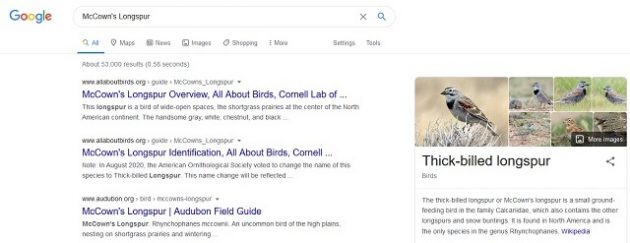
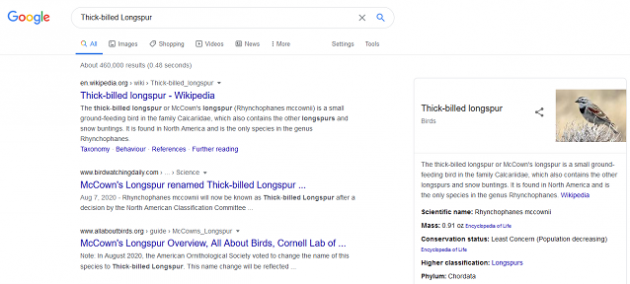
But in 2020, perhaps the app example is more relevant than the book or museum examples. Apps are routinely updated, and webpages can be quickly renamed, with links retained. We promptly adapt to a new Facebook interface, which touches far more people than the name for Sabine’s Gull. The Google algorithm has already largely adapted to Thick-billed Longspur (see above) and the Wikipedia page was updated within minutes of the formal announcement. Maybe our dynamic interconnected world can seamlessly incorporate such changes. Perhaps the value of stability in 2020 is less than it was in 1983.
But maybe not. I still use printed field guides, and, as of today, even the Cornell Lab of Ornithology has not updated its All About Birds (and eBird) webpages for what it still calls McCown’s Longspur, though there is a note that the name will be changed with the next taxonomic update (see below). There are people who know that bird by its old name and that association will persist. And that is for a fairly uncommon bird with a modest range, unlike, say, Clark’s Grebe.
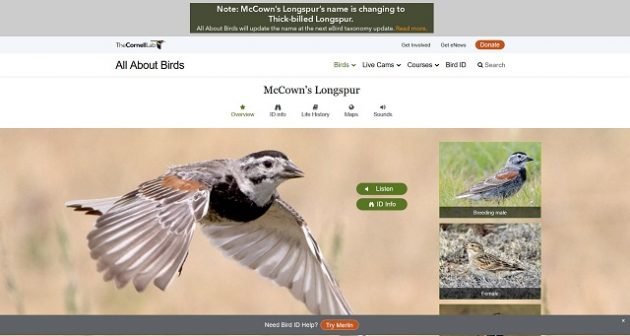
Even the app example is ambiguous. Searching for “Western Scrub-Jay” on the Sibley or Merlin apps is futile, as they do not redirect to either California Scrub-Jay or Woodhouse’s Scrub-Jay, but instead generate no results at all. This is true even if you are standing directly in front of a sign describing the “Western Scrub-Jay” in a visitor center or on a trail. (The descriptive text of both apps does provide a history of the names.) This may seem irrelevant to people with the background and interest to debate bird taxonomy, but it is confusing to everybody else.
Thus, there is surely a cost to name changes, though it may be modest and acceptable. I have looked for empirical analysis on this issue and have been unsuccessful in locating anything that appears authoritative, though this is admittedly not my field, so I have probably missed something. Please let me know if there is something out there. If there is truly nothing, perhaps this received wisdom should be reexamined.
Without a broad sense of the magnitude of the cost of change, it is difficult to assess proposals to change a single name, let alone dozens. All proposals sound good if only the benefits are considered and the costs are ignored.
Even without meaningful data, it appears that birders are more than capable of adapting to the occasional name change without serious disruption. I assume the same is true for ornithologists and other professionals, who likely use common names less than birders anyhow. Laws and regulations can be updated over time (e.g., the list of birds protected by the Migratory Bird Treaty Act). Field guides and signs can be periodically replaced.
But the apparent ease of adapting to one or two changes a year is different than 10 or 25 or 50 or 142, even if spread over several years. Moreover, the usual year-to-year changes for traditional reasons (e.g., splits) would continue, in addition to any changes for values or inclusivity.
I have no idea which side of the debate a cost-benefit analysis might favor, as it would depend on the facts. If the costs of change are minor and short-lived, perhaps that suggests changing more names. But if the costs are significant and long-lived, perhaps would suggest changing only the worst ones or making changes over a longer period of time.
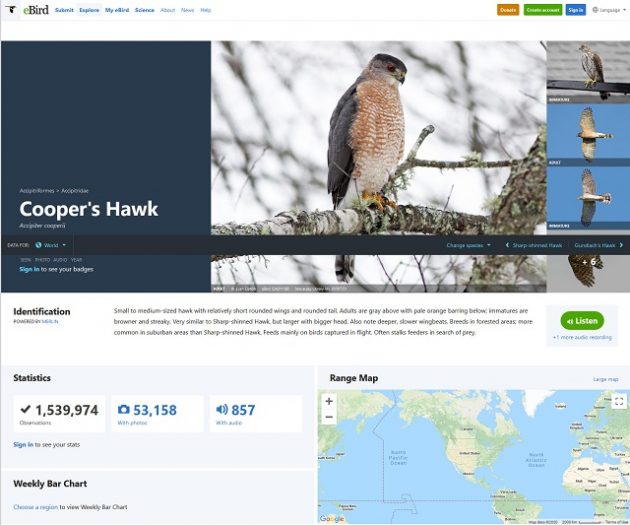
The cost of change is also likely different for different birds. There are surely more costs associated with changing the names of relatively common birds (e.g., Cooper’s Hawk, which has more than 1.5 million observations on eBird) than uncommon birds (e.g., Kittlitz’s Murrelet, which has fewer than 3,000). For that particular example, there are many webpages, articles, and signs dedicated to distinguishing Cooper’s Hawk from Sharp-shinned Hawk.
Of course, the current controversy over names is one of values, which are difficult to assess empirically. But even if we place a high value on our values, costs cannot be ignored. Rather, the argument should include some consideration of whether the benefits outweigh the costs.
UPDATE: On April 16, 2021, the Diversity and Inclusion Committee of the American Ornithological Society (AOS), had a “Community Congress on English Bird Names” to discuss whether certain bird names should be changed. My summary is here.
The image at the top is a Wilson’s Snipe, named after the American ornithologist Alexander Wilson.













Not relevant, now is it? Names are binomial, Linnaean system and the rules are clear, internationally agreed upon and the same everywhere. Besides, English names are silly for a whole lot of other reasons – look at Merops bullockoides, is the “white front” really the bit that strikes you? And before you ask reagrding this “Latin” name, William Bullock was a nice guy – he refused to be part of a racist spectacle.
I think that Merops bullockoides (White-fronted Bee-eater) isn’t the best example, as a white facial area isn’t really a common thing for a bee-eater, wouldn’t you reckon?
Bird books are outdated with EVERY change that happens on a yearly basis. Whether a lump, split or taxonomic re-ordering, the minute you buy a bird book, create a museum display, it is assured to be out of date within a short period of time.
Thank you for your article on the costs of changing bird names. I am a white naturalist in the very diverse (humanly and in terms of avifauna) San Francisco Bay Area. I would like to add a few points, on the vital importance of integrating values.
Values sound abstract but they obviously bear implications. So one of the questions we should ask is who’s deciding and for whom? If the taxonomists are still white men, they might only find cost a most important issue. If the deciders were black birders such as Christian Cooper, who was falsely accused of assault by a white woman in Central Park, and black naturalists such as Rue Mapp, the founder of Outdoor Afro, then the importance of removing references to slave-owners and other exploiters could outweigh the monetary costs because the psychological cost of just keeping the old terms are equivalent to experiencing constant microaggressions.
Names are not only used by scientists. They are used by amateur birders, kids, teachers, backyard birders, etc. The question does not only impact taxonomists and birders, but a wide swath of the public that enjoys bird-watching. In the same light that our children’s textbooks should provide objective history, the public should be able to use names associated with the bird’s characteristics, not the legacy of exploitation.
Secondly, when new DNA testing split up some bird species and even disappeared some genuses, no one blinked about cost, that is, no cost-benefit analysis was done that I know of. They might have argued about nomenclature and categories, but not how many dollars it would take to make things scientifically right. If we truly integrate the values of being against structural racism, for example, then we must, in my opinion, elevate the value of obliterating all vestiges of it. The point here is you cannot separate one from the other.
On the issue of stability, if we don’t anticipate that the coming period will be unstable, then we are not in touch. We not only have the major instability caused by the Corona virus, but we have the dynamic protest movement caused by the epidemic of police murders of black people. We are facing an election that will have calamitous consequences whichever way it goes, but definitely instability to say the least. Challenging the results is only one of them.
Finally, bird science is not the only field that has to examine its nomenclature. Dictionaries, which have far more items to deal with, must make changes. I just checked a thesaurus for catastrophic and one of the synonyms was black. If that doesn’t scream “we need change,” I don’t know what would.
I generally feel that birds should have names that reflect their appearance, habits, or habitat. That said, it’s way too late to go about changing the hundreds or thousands of names for reasons that effect little actual change, and appear to be a knee-jerk reaction to current events….the slippery slope argument. Changing (only the common) name of McCown’s Longspur because McCown followed his state’s secession (10 years later) into the Confederate Army, while ignoring the fact that virtually every Union general actively participated in the genocide of Native Americans, is ridiculous. For a much more articulate argument of this position from BirdChat, see:
http://birding.aba.org/message.php?mesid=1696016&MLID=BC&MLNM=BirdChat
I don’t think that human history should be mixed with natural history. No bird, or any nonhuman species, should be named because of any relation it may have had to a human, whether deemed good or bad. We humans will always find the good, the bad and the ugly in our history, but give nature a break and leave it value-free, which is what gives us the solace and freedom from the more sordid chapters of human history when watching any bird in the very present moment.
I’m fine with changing the names and elimination many, or all, of the human names from common names. As Leanne says, the issues are greater than cost. What I cannot support is the decision by Sibley and Merlin to totally ignore the old names. Somehow they must help the new or casual birder and those of us who are too poor to purchase every new guide to keep up.
I traveled in southern Africa in 1912 shortly after many of their common names were changed to match the names in the English language to what the rest of the world used. This created problems as some of the guides used old names and some used the new ones. The book I found myself using the most has a list of all the changes with both old and new names.
For an electronic guide to not take advantage of the computer’s possibilities to include both names hurts all of us who want the sport to grow.
Note that your cropped screenshot of the All About Birds page for McCown’s Longspur leaves out the very clear notice at the top of the page that the name has recently changed and will be reflected during the next update of the eBird taxonomy.
Hugh, good catch, thanks! That space is almost always advertising so I didn’t even notice it. That’s rather a poor place to put content given that many people ignore it. But I confess my error. However, that still does not change the fact that there’s no result if you search for “Thick-billed Longspur.”
I have updated the All About Birds image and associated text to more accurately reflect the facts about the Cornell Lab of Ornithology web pages. Thanks for pointing out the issue.